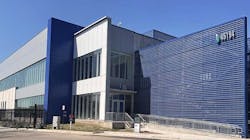A Converged Digital Vision: Colony Capital Rebrands as DigitalBridge
There’s a lot in a name. This week Colony Capital said it is changing its name to DigitalBridge, a move that aligns its brand with CEO Marc Ganzi’s vision for a company driving the transition to a cloud-powered future.
The rebranding is a key milestone for Colony, which has been selling off a portfolio of hotels, hospitals and office properties as it works to create a real estate investment trust (REIT) that specializes in the convergence of digital real estate assets. That transformation is reflected in the switch to DigitalBridge, the operating company that acquired data center operators Vantage and DataBank before becoming part of Colony Capital.
“Today marks a new chapter in our history as we emerge from this transformation as a fast-growing global digital infrastructure REIT,” Ganzi said in the announcement. “This is the natural moment for us to reactivate DigitalBridge, advancing our strategy as we connect networks, companies, geographies, and communities on a global basis. We’re a unique digital infrastructure business, with both the operating DNA and access to institutional capital that positions us to execute globally on a converging digital infrastructure ecosystem.”
Ganzi expanded on his vision for DigitalBridge Tuesday in a discussion with Nareit CEO Steven Wechsler at the REITweek Investor Conference. The goal of DigitalBridge is to create the world’s first global diversified digital investment platform.
“This is the digital REIT of the future,” Ganzi said. “Digital real estate is so important right now. It’s a catalyst for digital transformation.”
A Portfolio That Spans Digital Asset Classes
The DigitalBridge investment thesis encompasses everywhere data may travel, from the fiber in the ground to the wireless signals moving across the network to the devices, and just about every type of building along the way where data may be stored or processed.
This is reflected in DigitalBridge’s expansive approach to digital real estate, which includes data center companies like Vantage and DataBank, but also telecom towers, small cells, fiber and edge computing. Its latest deal is the $854 million acquisition of Boingo Wireless, which provides wifi and cell service for commercial real estate properties.
“We have this view around converged networks,” said Ganzi. “Our customers have led us to this place. They are not just buying data centers, or towers – they are buying everything. They’re buying fiber to connect to the data centers, they need towers to connect the signals, but they also need antennas and edge compute sites to get these applications closer to your home.
“This old notion of a siloed approach where you just own cell towers, Or just own data centers. What we’re saying to investors is that you don’t have to choose.”
At Data Center Frontier, we’ve been tracking this evolution of multi-sector strategies that spread investment across the entire spectrum of digital infrastructure assets. These multi-sector strategies can be complicated, as expertise doesn’t translate neatly across technology boundaries, and asset valuation vary across different types of infrastructure.
Ganzi’s solution is to work with a range of investors and talent, using multiple vehicles to align investment criteria and business goals. The result is a complex mosaic of companies designed to manage risk and capture targeted opportunities in digital infrastructure.
Navigating A $100 Billion Shift Amid a Global Pandemic
Ganzi has been working in the infrastructure sector since 1994. In 2002 Ganzi and partner Ben Jenkins founded Global Tower Partners (GTP), the largest privately-owned tower company, which grew to 16,000 sites before it was acquired by American Tower for $3.3 billion. Ganzi and Jenkins founded DigitalBridge in 2013 with a “singular focus” on owning and operating communications infrastructure companies with strong cash flow.
That game plan has extended to Colony, which acquired DigitalBridge in 2019. Ganzi took the helm last year, succeeding long-time Colony CEO Thomas Barrack, and quickly accelerated the company’s digital transition.
Investors have reaped the benefits of the turnaround effort. Shares of Colony Capital dipped below $2 a share in the early weeks of the COVID-19 pandemic amid investor concern about the company’s exposure to hotels and offices. Shares of Colony are now trading above $8 a share, as the markets have been impressed with its asset divestitures and M&A. Digital real estate holdings now represent 76 percent of Colony’s assets under management, the result of a $100 billion rotation to digital properties.
“We had to make a lot of tactical moves to navigate this massive shift to digital,” said Ganzi, including a process to triage real estate holdings that were impaired by the impact of the pandemic. “During the pandemic, we had to keep people connected. It put a lot of pressure on our portfolio companies, but was really a defining moment for our sector and asset class.”
It’s not yet clear whether the DigitalBridge brand will extend beyond the holding company level, as most of its 22 holdings continue to operate under individual brands that have built considerable market awareness, such as Vantage and DataBank. The company is expected to share more information about its strategy and rebranding at its investor day June 22.
One thing is clear: Ganzi sees plenty of runaway for the growth of digital infrastructure.
“The amount of capital being put into digital real estate today is a staggering figure,” Ganzi said at REITweek. “It was $378 billion last year. will be over $400 billion this year, and $435 billion in 2022. That’s $1.2 trillion of construction in digital real estate. That’s just enormous. Digital real estate is growing faster than traditional real estate. We’re serving our tenants with the networks of the future. and the real estate that’s required to build them.
“Everything is about building roads to the future.”
About the Author



